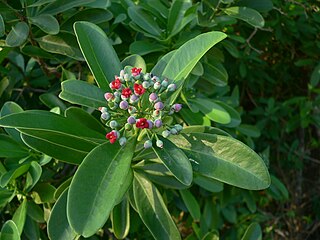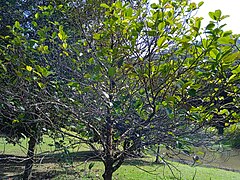
Syzygium samarangense is a species of flowering plant in the family Myrtaceae, native to an area that includes the Greater Sunda Islands, Malay Peninsula, and the Andaman and Nicobar Islands, but introduced in prehistoric times to a wider area and now widely cultivated in the tropics. Common names in English include wax apple, Java apple, Semarang rose-apple, and wax jambu.

Diospyros virginiana is a persimmon species commonly called the American persimmon, common persimmon, eastern persimmon, simmon, possumwood, possum apples, or sugar plum. It ranges from southern Connecticut to Florida, and west to Texas, Louisiana, Oklahoma, Kansas, and Iowa. The tree grows in the wild but has been cultivated for its fruit and wood since prehistoric times by Native Americans.

Castanopsis cuspidata is a species of Castanopsis native to southern Japan and southern Korea.

Diospyros mespiliformis, the jackalberry, is a large dioecious evergreen tree found mostly in the savannas of Africa. Jackals are fond of the fruit, hence the common names. It is a member of the family Ebenaceae, and is related to the true ebony and edible persimmon.

Podocarpus elatus, known as the plum pine, the brown pine, the Illawarra plum or the Queensland Christmas tree, is a species of Podocarpus endemic to the east coast of Australia, in eastern New South Wales and eastern Queensland.

Dillenia indica, commonly known as elephant apple or ou tenga, is a species of Dillenia native to China, India, and tropical Asia. It is found in stony river banks.

Mimusops elengi is a medium-sized evergreen tree found in tropical forests in South Asia, Southeast Asia and northern Australia. English common names include Spanish cherry, medlar, and bullet wood. Its timber is valuable, the fruit is edible, and it is used in traditional medicine. As the trees give thick shade and flowers emit fragrance, it is a prized collection of gardens. It is used as an ornamental tree in many places. The flowers may also be used in natural perfume.

Canella is a monospecific genus containing the species Canella winterana, a tree native to the Caribbean from the Florida Keys to Barbados. Its bark is used as a spice similar to cinnamon, giving rise to the common names cinnamon bark, wild cinnamon, and white cinnamon.

Mallotus philippensis is a plant in the spurge family. It is known as the kamala tree or red kamala or kumkum tree, due to the fruit covering, which produces a red dye. However, it must be distinguished from kamala meaning "lotus" in many Indian languages, an unrelated plant, flower, and sometimes metonymic spiritual or artistic concept. Mallotus philippensis has many other local names. This kamala often appears in rainforest margins. Or in disturbed areas free from fire, in moderate to high rainfall areas.

Chionanthus foveolatus, commonly known as the pock ironwood or bastard ironwood, is a medium-sized, evergreen, Afromontane tree that is native to South Africa, Eswatini and Malawi.

Inocarpus fagifer, commonly known as the Tahitian chestnut or Polynesian chestnut, is a species of flowering plant in the subfamily Faboideae of the legume family, Fabaceae. The tree has a wide range in the tropics of the south-west Pacific and south-east Asian regions, and a history of traditional use by the peoples of Polynesia and Melanesia. It is the only edible and culturally important member of the genus Inocarpus.

Cinnamomum mercadoi (kalingag) is a small tree, about 6 to 10 metres high, with a thick, aromatic bark. The plant part of the family Lauraceae, which contains about 45 genera and 2000-2500 species, and is related to the culinary cinnamon, sassafras, and bay tree. The plant is indigenous to the Philippines, where it grows best in forests at low and medium altitudes that sometimes ascend to 2,000 metres (6,600 ft). C. mercadoi is unusual in the cinnamon family in that its essential oil consists large amounts of safrol, whereas other oils of cinnamon contain cinnamaldehyde. It is currently listed in the International Union for Conservation of Nature (IUCN) Red List as "vulnerable" due to the overharvesting and the continuous loss of the Philippine forests.

Chrysophyllum oliviforme, commonly known as the satinleaf, is a medium-sized tree native to Florida, the Bahamas, the Greater Antilles, and Belize. It is also known as damson plum, wild star-apple and saffron-tree. It gets the name "satinleaf" from the distinctive colors of the leaves. The top of the leaf is dark green while the bottom is light brown or copper. This distinctive look makes it a very aesthetically pleasing tree that is commonly used as an ornamental in yards and public spaces.

Parinari excelsa, the Guinea plum, is a species of large, evergreen tree in the family Chrysobalanaceae. It has a very wide distribution in tropical Africa and the Americas. This species grows to 50 m (160 ft) tall while the trunk is up to 1.5 m (5 ft) in diameter.

Artocarpus sericarpus, the peluntan, pedalai, gumihan or terap bulu, is a tropical evergreen tree species of the family Moraceae. It is the cousin of jackfruit and breadfruit.

Strombosia pustulata is a species of tree in the family Olacaceae. It is native to the rainforests of tropical West and Central Africa. Common names for this tree include itako in Nigeria, afina in Ghana, poé in Abé spoken in Côte d'Ivoire and mba esogo in Equatorial Guinea.

Drypetes gerrardii is a species of small tree or large shrub in the family Putranjivaceae. Common names include forest ironplum, bastard white ironwood, and forest ironwood. It is native to tropical and subtropical central and eastern Africa. It was first described in 1920 by the English botanist John Hutchinson, who named it after the English botanist William Tyrer Gerrard who collected plants and seeds in southern Africa in the 1860s.

Garcinia pseudoguttifera, known as the mo'onia tree in its native range, is a species of flowering tree in the family Clusiaceae (Guttiferae). The specific epithet (pseudoguttifera) comes from Greek pseudo and Neo-Latin guttifera.
Couepia polyandra, also known as olosapo, zapote amarillo, baboon cap, and monkey cap, is a flowering tree in the family Chrysobalanaceae.

Litsea garciae, also known as engkala, engkalak, kangkala, pangalaban and Borneo avocado, is a flowering plant belonging to the family Lauraceae and genus Litsea. It is native to Taiwan, the Philippines, Borneo, the Malay Peninsula, Sumatra, Java, and Sulawesi.























